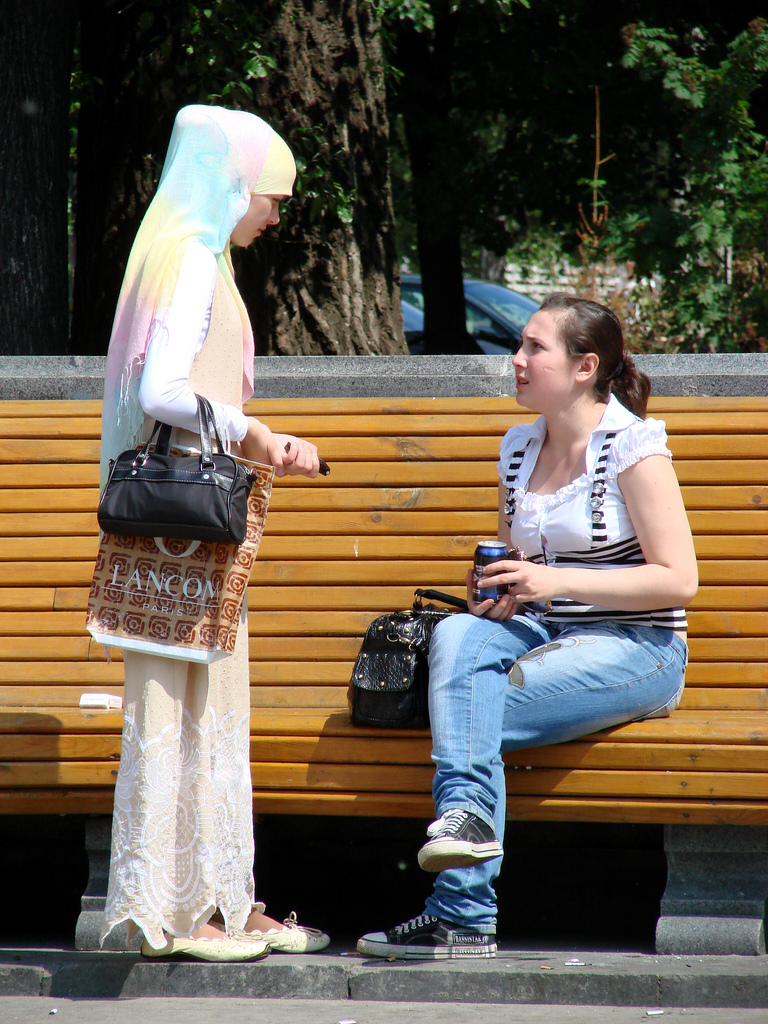Interpretations
 The information about veiling that is gleaned from Islamic religious texts (the Quran or the hadith), is ambiguous and open-ended. In fact, whether or not veiling is required in Islam, and the extent of that veiling, depends primarily on the interpretations of religious texts by Islamic scholars, as well as on the particular country a Muslim lives in.
The information about veiling that is gleaned from Islamic religious texts (the Quran or the hadith), is ambiguous and open-ended. In fact, whether or not veiling is required in Islam, and the extent of that veiling, depends primarily on the interpretations of religious texts by Islamic scholars, as well as on the particular country a Muslim lives in.
We provide here an overview of the traditional interpretations of Islamic texts, and of the more progressive interpretations of these same texts are they are developing today.
Traditional interpretations
Traditional interpretations of the Quranic verses treating women’s clothes were developed from the ninth to the thirteenth century, that is two to six centuries after the Prophet’s death. These interpretations were made by Quranic scholars, the most important of whom are undoubtedly Al-Tabari (b. 839, Iran); al-Razi (d. 1209); ibn al-Jawzi (d. 1200). This tradition of Quranic exegesis is known in Arabic as tafsir.
According to most traditional scholars, the Quran explicitly and unquestionably requires that Muslim women cover their entire bodies with loose fitting clothes and that they only leave their faces and hands uncovered. This interpretation of the Quranic verses continues to have a number of followers today, as can be observed by the way many Muslim women wear hijab around the world.
Some traditional Islamic scholars have opted for an even more extreme interpretation of the Quranic verses on women’s attire and asserted that the entire woman’s body ought to be covered, including hands and face. Some Muslim women feel swayed by this interpretation and dress in a manner consistent with this traditional view. Some Muslim rulers also have adopted this interpretation and required that women living in their country, whether Muslim or not, dress in this most conservative style. This is how we may interpret Muslim women’s adoption of a niqab (a veil that covers the face but not the eyes) or a burqa (a veil that covers both the face and eyes).
Progressive interpretations
Progressive Muslims is a group of pious Muslims from around the globe who are seeking to reinterpret Islam and core religious texts from an egalitarian, socially inclusive perspective. They believe that Islam, as is practiced around the world today, has been hijacked from the egalitarian spirit that was the core of the message that the Prophet received and preached in the seventh century. Their goal is thus to peel away the layers of interpretations that have been imposed on the Quran over the centuries and that have closed off the more open ended and fluid message of the Holy Book.
Progressive interpretations of the Quran
Progressive Muslims’ engagement with the Quran and with its exegetical tradition has led to the following conclusions:
- The Quran does not prescribe a specific dress code for women. Rather, it invites both men and women to observe culturally appropriate codes of modesty.
- The notion that Muslim women are required to veil is an interpretation of the Quran, rather than a prescription explicitly enjoined in the Quran. This interpretation has been superimposed on the Quran beginning in the ninth century by exegetes who read the Holy Book from the perspective of their own socio-cultural traditions.
- The only women who were required to veil during the Prophet’s time were his wives. In fact, in the seventh century, the verb “to veil” was synonymous to “become the wife of the Prophet”.
Progressive interpretations of hadith
 Progressive Muslims are also engaged in a rigorous examination of the hadith tradition and especially as it relates to Muslim women’s proper attire.
Progressive Muslims are also engaged in a rigorous examination of the hadith tradition and especially as it relates to Muslim women’s proper attire.
Progressive Muslims have called into question the reliability of Abu Dawud’s hadith and challenged the authenticity of his hadith based on their research into the massive scholarship of the hadith tradition. They have observed:
- Abu Dawud’s hadith is not reliable because it is cited only in this one collection and is not attested anywhere else. It thus exhibits the very feature marking possible fraudulent reporting according to the complex evaluation system of authentification developed by classical hadith scholars themselves.
- Abu Dawud’s hadith is not reliable because it is not supported by an unbroken chain of reporters going all the way back to the Prophet to guarantee its authenticity as all hadiths are supposed to be. It is cited only by Abu Dawud who lived in the ninth century, that is two hundred years after the Prophet’s death.
- Abu Dawud’s hadith is unreliable because the female body parts that ought to be concealed are not contained in the Prophet’s own words, but are specified by the hadith reporter himself, in this case, Abu Dawud.
Conclusion
For these reasons, progressive Muslims have concluded that Abu Dawud’s hadith is unreliable and cannot be considered an indisputable proof that Muslim women are required to veil their entire body, except for the face and hands, as some Muslims continue to believe.

